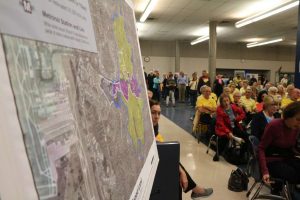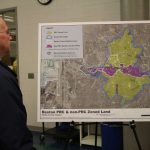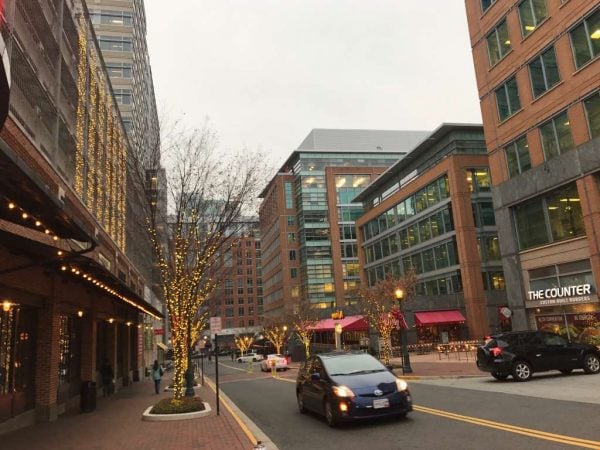
This is an op/ed submitted by Terry Maynard, co-chair of the Reston 20/20 committee. It does not reflect the opinions of Reston Now. It was updated on Sept. 27 with an editorial comment about the validity of the claims therein:
UPDATE: Mr. Maynard has acknowledged making a serious error in comparing the planned density of Reston’s TSAs to the density of Manhattan. Specifically, Manhattan’s density is not 26,000 people per square mile, it’s 72,000 people per square mile. Thus, Reston’s TSAs are not planned to become as dense as Manhattan, but could be as dense or denser than all the other New York boroughs. For more information, see Mr. Maynard’s detailed correction and apology in the comments section of this op-ed.
In a February 5, 2018 letter to Supervisor Cathy Hudgins, the Coalition for a Planned Reston (CPR)–a partnership of the Reston Citizens Association, Reclaim Reston, and Reston 20/20–called on the Supervisor to consider a variety of amendments to the Reston plan and to defer the Board of Supervisors’ plan to officially authorize advertisement of the proposed zoning amendment on March 6.
Given county claims that it needs to move forward with the increased density proposed in the Reston PRC zoning ordinance from 13 to 16 persons per acre because the Reston plan calls for it, the CPR letter and its recommendations focus on managing Reston’s growth in a way that would eliminate the need to increase zoning density.
Among other features, CPR’s recommendations for managing growth call for:
- A maximum population cap in all of Reston of 120,000 four decades from now at a time when its current population is about 62,000. This contrasts with the current plan’s language that would allow 160,000-180,000 people to live in Reston.
- Limiting density throughout Reston–including the Metro station areas–to 60 dwelling units per acre (DU/A) and limiting redevelopment in the Village Centers to the mixed-use areas only at a “neighborhood-serving” 30 DU/A.
- The elimination of special interest language permitting the massive–and inappropriate–redevelopment of the Saint Johns Wood apartment complex.
- The removal of the road that appears on two Reston plan maps across the Hidden Creek Country Club, opening it to development and endangering its future as a major Reston open space.
A second key theme in CPR’s recommendations is to build in assurances that the supporting infrastructure–road and parks especially–keeps pace with development. This is particularly true of the county’s need to acquire space for parks, schools, and other key infrastructure elements. The failure of Reston’s infrastructure to keep pace with recent development so far, including the extremely long lead times for major capital projects, has been a great concern of many Restonians. Part of this includes assurances that proffers generated by development are used in Reston.
The CPR recommendations also focus on assuring that new development is accompanied by a strong commitment to affordable housing, generally calling for developers to provide an onsite allocation of 20 percent affordable housing for each new project.
As these proposals suggest, CPR is anxious to see Reston grow, but to do so in a manner consistent with its creation as a planned community with a grand vision and vibrant planning principles. We believe that Reston’s future ought to continue to be planned and managed, not merely left open to effectively unconstrained commercial development as the current plan allows.
We hope Supervisor Hudgins sees that our proposals are consistent with that legacy and, following up on a meeting of RA and CPR leaders this week, will defer official county action on the PRC zoning amendment proposal. Then we can work with her and county staff to enable Reston to remain one of the world’s great planned communities.
Terry Maynard
Co-Chair Reston 20/20 Committee Member
Coalition for a Planned Reston
 Money Magazine has rated Reston as one of the best places to live in the country. Nothing new here. Reston has long been ranked among most desirable locations to live, work and play. As the magazine notes, “Robert E. Simon mapped out a vision of a community that upheld open space, recreational facilities and aesthetic beauty.” Further, Money explains, Reston “offers a woodsy atmosphere that includes expanses of parks, lakes, golf courses and bridle paths.”
Money Magazine has rated Reston as one of the best places to live in the country. Nothing new here. Reston has long been ranked among most desirable locations to live, work and play. As the magazine notes, “Robert E. Simon mapped out a vision of a community that upheld open space, recreational facilities and aesthetic beauty.” Further, Money explains, Reston “offers a woodsy atmosphere that includes expanses of parks, lakes, golf courses and bridle paths.”
Of course, Money’s brief report doesn’t capture all of Reston’s attractions, like the fact that we have always been a big hearted community that welcomes everyone, that we value development when it is appropriately supported by infrastructure and that preserving a quality of life for our children and grandchildren is more important than the passing obsessions of the day.
Perhaps more interesting than which communities are considered great places to live is to look at the sort of communities not on the list. You will search in vain for a Ballston, a Tysons, or a Rosslyn – and yet these are the models for what our County officials want us to become.
A show of hands – does anyone think that advocates of massively increased density in Reston care about your family’s quality of life? Anyone?
Reston has been a planned community for over fifty years. And for more than fifty years Reston has generally delivered on its promise of being a great place to live. Ballston and Tysons have many attractions – I have friends who are quite happy in both places – but they aren’t Reston. Nor do they want to be. And that’s fine. Let Tysons be Tysons – but let’s let Reston be Reston.
If you care about keeping the “planned” in our planned community, support the efforts of the community groups working to make sure Reston is on Money’s lists in 2023, 2028 and beyond. Please go to https://plannedreston.wordpress.com from more information. It’s your future.
Dennis Hays
President, Reston Citizens Association
(Editor’s note: If you wish to submit an op-ed, email [email protected].)
 A plan to increase population density in Reston’s Planned Residential Community (PRC) districts will head to the county’s Board of Supervisors in March.
A plan to increase population density in Reston’s Planned Residential Community (PRC) districts will head to the county’s Board of Supervisors in March.
County officials have set dates for upcoming hearings on the zoning ordinance amendment package, which drew fervent opposition during community meetings last year. The zoning change would increase the cap on the population per acre in the PRC from 13 to 16 people.
The amendment could also open up Reston’s village centers to increased major residential development. The proposal would allow the Board of Supervisors to approve developments above 50 residential units per acre within the district’s Transit Station Areas (TSAs) — so long as the projects comply with the area’s master plan that guides development.
The schedule for hearings is as follows:
- Board of Supervisors Authorization Item on March 6: The board will officially introduce the zoning ordinance amendment to its agenda.
- Planning Commission Public Hearing on April 5: The group will hear public testimony on the package. Verbal or written testimony will be taken. The applicant will be given the opportunity to respond to questions and issues raised by the commission and citizens. Registered associations have 10 minutes to speak, registered individuals have five minutes and unregistered individuals have three minutes.
- Board of Supervisors Public Hearing on May 15: The board will hear testimony from the public. Individuals are given three minutes to speak while organizations have five minutes. The board suggests bringing 15 copies of any materials for distribution. Individuals may sign up online.
The hearings are expected to last for several hours. At a late October public meeting at Reston’s South Lakes High School, passionate residents spoke out for roughly two hours against the proposal. The auditorium’s 600+ seats were full, with a solid perimeter of standing audience members as well, plus an overflow room nearby was full of even more people, following along on video.
County officials have said the zoning change implements updates to Reston’s Comprehensive Plan in 2014 and 2015 that calls for targeted, increased growth in Reston Town Center, the village centers and TSAs around the three Metro Stations.
Reston-based Leidos Offering Bonuses to Find New IT Hires — The company, which is the largest IT services contractor for the federal government, is offering a $2,000 bonus for every referral that results in a new IT hire. The company posted a third-quarter operating income of $151 million in revenue, a 34 percent jump in sales. [Washington Business Journal]
Coalition for a Planned Reston Holds “One Reston” Community Meeting — The coalition mobilized Monday night in opposition to a zoning amendment that would increase Reston’s population density, among other changes. After a discussion with attendees during the open floor meeting, the group plans to submit 10 suggested changes to the legislative package before the county by Christmas in order to better manage infrastructure and development. According to Terry Maynard, President of Reston 20/20, said the meeting attracted more than 130 attendees. “A key theme throughout was the necessity of the entire Reston community working together as ‘One Reston’ to meet the challenges of shaping the Reston plan and assuring individual development proposals meet the expectations of the community,” Maynard said. [Coalition for a Planned Reston via Youtube]
Herndon Middle School Bike Shop to Give Away Bikes on Saturday — Bicycles refurbished by the after school program that meets on Wednesday and Thursday afternoons, will be distribute to 10 children at the school. Recipients were provided by Cornerstones’ Neighborhood Resource Center in Herndon. Members of the club will provide and fit free helmets for recipients. [Fairfax County Public Schools]
Photo by Fatimah Waseem
 Opponents of a proposal before the county to increase Reston’s population density continue to mobilize ahead of community meeting on Monday night.
Opponents of a proposal before the county to increase Reston’s population density continue to mobilize ahead of community meeting on Monday night.
The Coalition for a Planned Reston, a community organization that includes Reclaim Reston, Reston 20/20 and the Reston Citizens Association, will gather community feedback about the proposal and discuss specific changes to scale back Reston’s master plan in an effort limit the scale of development in the planned community.
The proposal, which will go before the county’s Board of Supervisors, would increase the maximum allowed population per acre in the Planned Residential Community district from 13 persons up to 16.
The zoning change could also open up Reston’s village centers to increased residential development. The proposal would allow the Board of Supervisors to approve developments above 50 residential units per acre within the district’s Transit Station Areas (TSAs) — so long as the projects comply with the area’s master plan that guides development.
Reston Association staff opposed the changes. In a letter, In the letter, the RA staff also asks county supervisors to hold off on any further consideration of the PRC density cap increase until RA staff and county staff together can examine the Reston Master Plan portion of the county’s Comprehensive Plan.
Meanwhile, the coalition will pitch amendments to Hunter Mill District Supervisor Cathy Hudgins before Christmas. Overall, the coalition is seeking to constrain density growth and ensure infrastructure keeps up to pace with development.
CPR hopes to maintain the intensity of opposition to the proposal, which eclipsed in late October during a 900-person public community meeting in Reston where an overwhelming majority of attendees opposed the proposal.
“We are anxious to present what we believe are reasonable Reston plan amendments to Supervisor Hudgins rather than just denoting a list of topic areas where changes could be made,” said Terry Maynard, co-chair of the Reston 20/20 Committee. “We are hopeful that the community will buy in to these proposals and possibly suggest some modifications and additions.”
Changes under consideration include reinstating a population cap throughout Reston which existed in the community’s 1989 plan; placing a cap on high-density, high-rise residential development, which the coalition stated is unlimited in the current plan; and phasing development with supporting infrastructure similar to the Tysons plan.
On a broader level, the coalition seeks to ensure county policies and standards that govern schools, parks and transportation are realistically in line with Reston’s growth potential.
CPR will also use the meeting platform to discuss other controversial zoning matters, including the “densification of Saint Johns Woods” and the addition of a road through Hidden Creek Country Club.
“The last minute inclusion by the Planning Commission of developer language allowing Bozzuto to re-develop St. Johns Woods at triple its current density is a perfect example of community exclusion in the development process,” said Reclaim Reston member Bruce Ramo.
The meeting will be held on Monday at 7 p.m. in the Reston Association Conference Center.
A zoning change to allow for more development and accommodate population growth was discussed during The Kojo Nnamdi show Wednesday — a conversation that painted the ongoing issue as a microcosm of a perennial debate on how to manage development, growth and public infrastructure.
Leslie Johnson, zoning administrator for Fairfax County, said the zoning change, which would increase the population density per acre from 13 to 16, along with a host of other changes that implement the Reston Master Plan, a planning document that lays out the vision for the area, said Fairfax County officials are working hard to ensure development matches the pace of public infrastructure.
She also noted the county is aware of the need to preserve already stable residential neighborhoods that surround areas along the Metro that are targeted for growth.
“We can’t stop development waiting for the roads to be built,” Johnson said, adding that the county recently developed a funding plan for road infrastructure and developers are helping in tandem.
Johnson noted that the zoning change was consistent with master plans adopted in 2014 and 2015. She also said she was encouraged by vehement opposition that surfaced in two community meetings earlier this year.
“It’s a good sign that people are engaged because we get criticized for not engaging enough. I think peoples’ voices need to be heard,” she said.
Nimbyism is not the rallying point for people opposed to the zoning change, according to some residents.
Terry Maynard, co-chair of Reston 20/20, a citizen activist group that is against the proposal, said many people are opposed to the scope of development, not development itself.
Absent adequate public infrastructure for current residents, allowing more population density in pockets in Reston damages residents’ quality of life. He also noted projections about population increases as a result of the zoning change do not account for growth from affordable housing units and bonus density allowed for some developments.
“The Reston Master plan is very weak in defining infrastructure needs for the community in sharp contrast for a similarly-prepared plan for the Tysons area,” he said.
The cart-before-the-house argument has been echoed in community meetings.
But, to some extent, the zoning change is an exercise in how open communities are to change, especially as the county is in “a state of transition” in anticipation of Metro, which the county has been preparing for for the last 20 years, Johnson said.
Amendments to the zoning change are expected. The county is leaving the board with the flexibility to determine what population density between 13 and 16 per acre is most feasible, she said. Johnson also said the county was open to changing the maximum number of residential units allowed per acre.
A round of public hearings are expected to begin early next year.
Virginia, unlike Maryland, is a conditional zoning state, which means it lacks the Adequate Public Facilities Ordinance, a mechanism that attempts to manage growth by ensuring adequate roads, schools and public facilities are in place as development occurs. APFO laws vary by state and county.
A complete recording of the show is available online.
 Reston Association staff posted a copy of a letter sent to Fairfax County Supervisor Cathy Hudgins officially opposing the county’s proposed increase in the Planned Residential Community (PRC) District Residential Density Zoning Ordinance Amendment, following last week’s community meeting.
Reston Association staff posted a copy of a letter sent to Fairfax County Supervisor Cathy Hudgins officially opposing the county’s proposed increase in the Planned Residential Community (PRC) District Residential Density Zoning Ordinance Amendment, following last week’s community meeting.
The amendment would increase the maximum allowed population per acre in the Reston PRC from 13 persons up to 16.
The zoning change could also open up Reston’s village centers to increased major residential development. The proposal would allow the Board of Supervisors to approve developments above 50 residential units per acre within the district’s Transit Station Areas (TSAs) — so long as the projects comply with the area’s master plan that guides development.
The letter comes in response to spirited opposition from several hundred people who attended a public meeting on Monday, Oct. 23 at Reston’s South Lakes High School. Passionate residents spoke out for roughly two hours against the proposal. The auditorium’s 600+ seats were full, with a solid perimeter of standing audience members as well, plus an overflow room nearby was full of even more people, following along on video. A video of the meeting is available to watch on RA’s YouTube channel.
The letter thanks Sup. Hudgins and the other board members for providing detailed information and holding the community meeting, which RA staff said were “crucial in order to reach an informed decision regarding whether or not to support the amendment, proposed by County staff.”
“The Community Meeting held at South Lakes High School on October 23, 2017, with well over 900 in attendance, was informative. Based on both the County staff panel discussion and the community comment, the Reston Association Board of Directors opposes the County Staff’s proposed PRC District Residential Density Zoning Ordinance Amendment,” the letter reads.
In the letter, the RA staff also asks county supervisors to hold off on any further consideration of the PRC density cap increase until RA staff and county staff together can examine the Reston Master Plan portion of the county’s Comprehensive Plan: Read More



